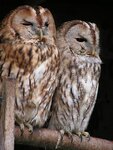

Tweetings, fellow birders! Thanks for flying in to read this column! This week we'll give a hoot and grab a glimpse at the gifted night flyer known as the owl. Often heard but seldom seen, these nocturnal neighbors can be hard to spot (but rest assured, they are there!)
Let's have a closer look at some of the types you might hear fluttering in the quiet distant darkness.
1. Great Horned Owl -- This is the bird you'll find most often on those creepy Halloween decorations! Found all across the New England region, they'll be recognized by their distinct ear tufts and yellow eyes. Heard most often in winter, as they seek mates during this time from Dec-Feb, their call is the classic "hoot," usually emitted in blasts of 3-5 (hoo-hoo-hoo!).
2. Barred Owl -- A lovely bird with rounded head and soft light-colored feathers, this is perhaps the most common species in your area. Somewhat of a shy fellow, they prefer to remain within forests and less-populated areas.
3. Barn Owl -- Recognized by their white heart-shaped face and pale breast feathers, you'll find them hunting in open country. Prone to nesting in abandoned structures (hence the "barn" reference in their name).
Eastern Screech Owl -- You'll hear this one before you see it, their shrill call and chatter echoing deep within the New England night. Prefers forests, nesting in tree holes, but will also take to roosting in human-made boxes found in suburban areas.
5. Northern Saw-Whet Owl -- This tiny owl, less than a foot in height, is rather elusive and difficult to spot. Consider it a real treat if you do so. Luckily their population seems to remain steady in Massachusetts.
6. Long-Eared Owl -- Similar in appearance to Great Horned Owls, this startled-looking bird is hard to find in the Bay State. Tend to breed along the coast. Look for them on Cape Cod and Martha's Vineyard.
7. Short-Eared Owl -- This handsome but erratic flyer hunts in open country and nests on the ground. Found in marshes and wetlands. Another resident you may find on the islands off of Cape Cod.
Now, being nocturnal birds of prey, owls hunt mainly small mammals (rats, mice, voles) and insects, as well as smaller songbirds. Their highly specialized hearing and sight make them excellent hunters during the night hours, using their sharp talons and curved beak to dispatch their targets. Signs of an owl living in your area may be pellets found at the bases of trees or scattered along the ground. This is because the birds often swallow their prey whole and thus have to regurgitate the bones, teeth or fur, purging them from their system in this manner.
Other signs of the presence of owls are of course their distinct calls or "hoots." These will be heard most often either at dusk or early dawn, as the bird is either headed to work or off to bed! Cries, shrills or toots are other familiar sounds, as well as cackles, whinnies and gurgles. Because of this, and their eerie nighttime schedules, owls are often associated with mythology, folklore and the occult.
Owls are found all over the world and have been featured in artwork dating from thousands of years ago.
Owls have 14 neck vertebrae and can rotate their heads close to 270 degrees (ouch!).
Female owls are typically larger than the males.
A group of owls is referred to as a "parliament." (Let's come to order, everyone!)
Okay, now that we've reached the final portion of the article, please let me say this: owls are, as I said, birds of prey, and therefore can be extremely dangerous. Because of this, if you do decide to seek them out for observation, please do so from a safe and reasonable distance. Binoculars are always recommended, and above all, do not approach the bird directly, as they may feel threatened. Odds are they will not attack you, as humans are not on their menu, but again, you never know (Better safe than sorry). As well, if you go searching in the night, please bring a flashlight and watch out for animal traps (especially in rural areas). Above all, always exercise precautions. Remember, I give a "hoot" about you, too!
And, of course, we end with a bad joke:
Q: What do you get if you cross an owl with a goat?
A: A "hootenanny!"
Yes, I got that one from an old cartoon!
Happy Birding!